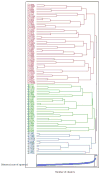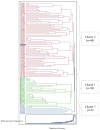Detecting subgroups in children diagnosed with pervasive developmental disorder - not otherwise specified
- PMID: 25374133
- PMCID: PMC5391033
- DOI: 10.1007/s10803-014-2295-3
Detecting subgroups in children diagnosed with pervasive developmental disorder - not otherwise specified
Abstract
Hierarchical cluster analyses were used to detect three subgroups in a sample of children with pervasive developmental disorder--not otherwise specified (PDD-NOS) evaluated at ages 2 and 4. At age 2, Cluster 1 demonstrated few autism symptoms and high cognitive scores; 60% no longer met criteria for PDD at 4. Cluster 2 exhibited more autism symptoms and lower cognitive scores at 2; 89.5% met criteria for ASD at 4. Cluster 3 had the lowest cognitive scores and most impaired social/communication skills at 2, but no repetitive behaviors; 60% diagnosed with Autistic Disorder at 4. Results shed light on outcomes for different PDD-NOS types and raise questions regarding the increased importance of repetitive behaviors in DSM-5.
Figures







References
-
- Aldenderfer MS, Blashfield RK. Cluster analysis. Beverly Hills; London: Sage; 1984.
-
- American Psychiatric Association. Diagnostic and statistical manual of mental disorders: DSM-IV-TR. American Psychiatric Publishing, Inc; 2000.
-
- American Psychiatric Association. DSM 5. American Psychiatric Association; 2013.
-
- Baron-Cohen S, Allen J, Gillberg C. Can autism be detected at 18 months? The needle, the haystack, and the CHAT. The British Journal of Psychiatry. 1992;161(6):839–843. - PubMed
-
- Bateson G. A theory of play and fantasy. Psychiatric research reports. 1955;2(39):39–51. - PubMed
Publication types
MeSH terms
Grants and funding
LinkOut - more resources
Full Text Sources
Other Literature Sources
Miscellaneous

